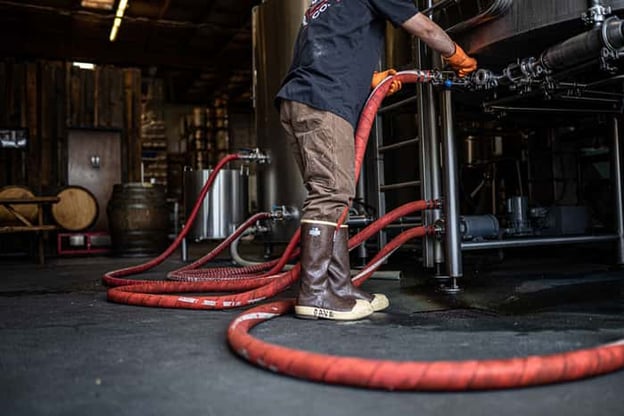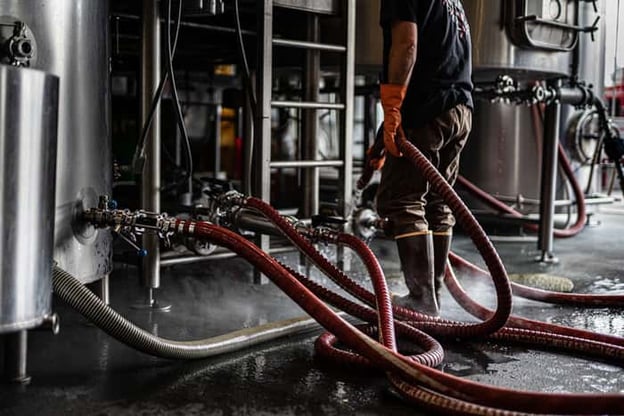10 Best Restaurant Shoes and Brewers Boots for Hospitality Workers
When it comes to buying the best kitchen shoes or brewers boots, options abound. Just make sure you consider these four key elements before making any purchases.

Photography courtesy of XTRATUF
Comfort Is Key
For someone working in a profession that requires them to spend ten-plus hours on their feet, comfort will be key when it comes to footwear.
Shoes that are too snug will only cause more damage as the day wears. Look for a shoe that gives your digits ample room to wiggle around in the toe area. Think of it this way: You want to wear the shoe as opposed to the shoe wearing you.
Most importantly, find a shoe that supports the natural arch of your foot. A shoe of this nature will be more comfortable, reducing the risk of injury such as ankle sprains or rolled ankles. A handy trick here to figure out if you have a shoe with good arch support is to bend it in half. If the shoe bends all the way, then it won’t provide the type of structure and support you need.
Pro tip: Shoes with rubber outsoles are best because they reduce the pressure on your feet as you move about in the kitchen, in the front of house, behind the bar, or in the brewery.
Good Grip
It is essential that any kitchen shoe or brewers boot provides you with a good grip. As we just mentioned, your day in a restaurant or brewery will most likely include a variety of spills.
Wearing a slip-resistant shoe will help keep you and your employees safe, avoiding injury.
There are two things that make a good slip-resistant shoe:
Material: You want a shoe that has an outsole made of soft rubber. The outsole is the part of the shoe that directly contacts the ground. Soft rubber is more slip resistant to compounds like water and oil, creating a more stable shoe. One with a greater grip on a slippery floor. A slip-resistant shoe with a soft rubber outsole will have a better chance of grabbing hold in compromising situations than a regular shoe with a harder non-rubber outsole.
Design: Slip-resistant shoes use what’s called an interlocked tread pattern. The purpose of this design is to make sure that water doesn’t become trapped in the bottom of your shoe, but instead flows out and away from your foot. This helps prevent slips.
On the other hand, enclosed tread patterns (like those you’ll often find in gym or tennis shoes), trap the water in their treads. With nowhere to go, the liquid stays put, creating a scenario similar to a hydroplaning car—your feet will slide on top of the water, unable to get a firm grip.

Photography courtesy of XTRATUF
Water-Resistant for Kitchen Shoes, Waterproof for Brewers Boots
As we’ve mentioned, chances are in a restaurant, bar, or brewery there will be spills. It’s a hazard of the job that you’ll have beer, water, or other liquids make their way onto you or the floors at some point during the day. That’s why water-resistant shoes for restaurant workers and waterproof boots for brewers are crucial.
There is a pretty important difference here. For your workers in the front-of-house or back-of-house you’ll want a water-resistant shoe.
You or your employees don’t want to spend the whole day walking around with soaked feet. A pair of water-resistant shoes will prevent that from happening.
Warning: In the kitchen you’re NOT looking for waterproof shoes. Okay, stay with us here. It seems like waterproof shoes would be the best option right? Waterproof protection is graded on a scale from IPX-0 to IPX-8, with IPX-8 offering the most amount of protection. What could be better than keeping water completely out? Well, if your shoe is impervious to water that means it also does an incredible job of keeping any moisture inside. Eventually, moisture will build up inside your shoe, which can be problematic. Just think of how sweaty your feet get after an eight-hour shift serving beer or cooking.
The move here is to go with a water-resistant shoe NOT a waterproof shoe. Look for shoes made of common water-resistant materials such as nylon, polyurethane, or neoprene.
In the brewery, you’re much more likely to come in contact with more liquid more often (think hosing down floors, walking on wet brew decks, etc), so you’ll want to look for a waterproof brewers boot.
The most important difference here is that in addition to water, brewers can often come in contact with various chemicals, which is why it’s best to look for a waterproof boot.
Don’t Underestimate Durability
When looking for the best kitchen shoe or brewers boot, this isn’t the time to go cheap. You want to find a shoe that has durability. One that’s made with materials that are built to last.
Just think about it: You’re going to be moving around in these shoes for at least eight to ten hours per day for the foreseeable future. You’ll be moving from the mash tun to the fermenter, walking from the kitchen to a table, shuffling around from the taps to the bar tops. You want to find a shoe that’s up to the task (we have some suggestions in The 10 Best Restaurant Shoes and Brewers Boots Available section below).
Don’t skimp on security here. Buying a kitchen shoe or brewers boot is an investment. Trust us, it will be worth it in the long…run.
